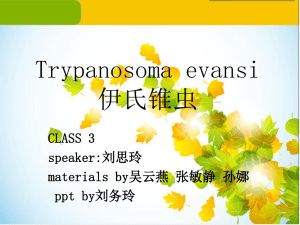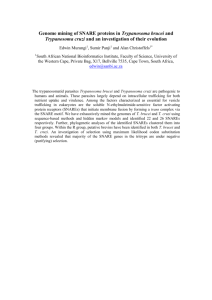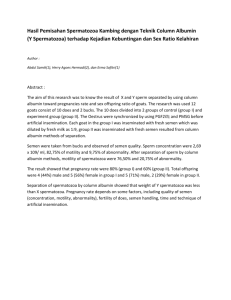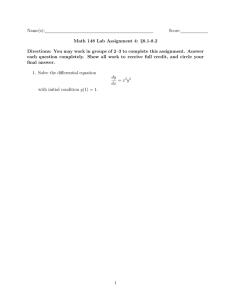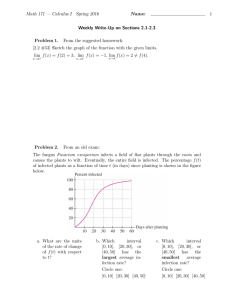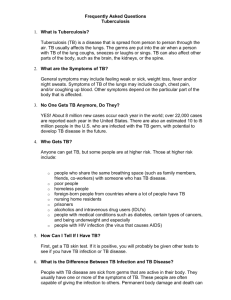International Journal of Animal and Veterinary Advances 8(1): 14-20, 2015 DOI:10.19026/ijava.8.2393
advertisement
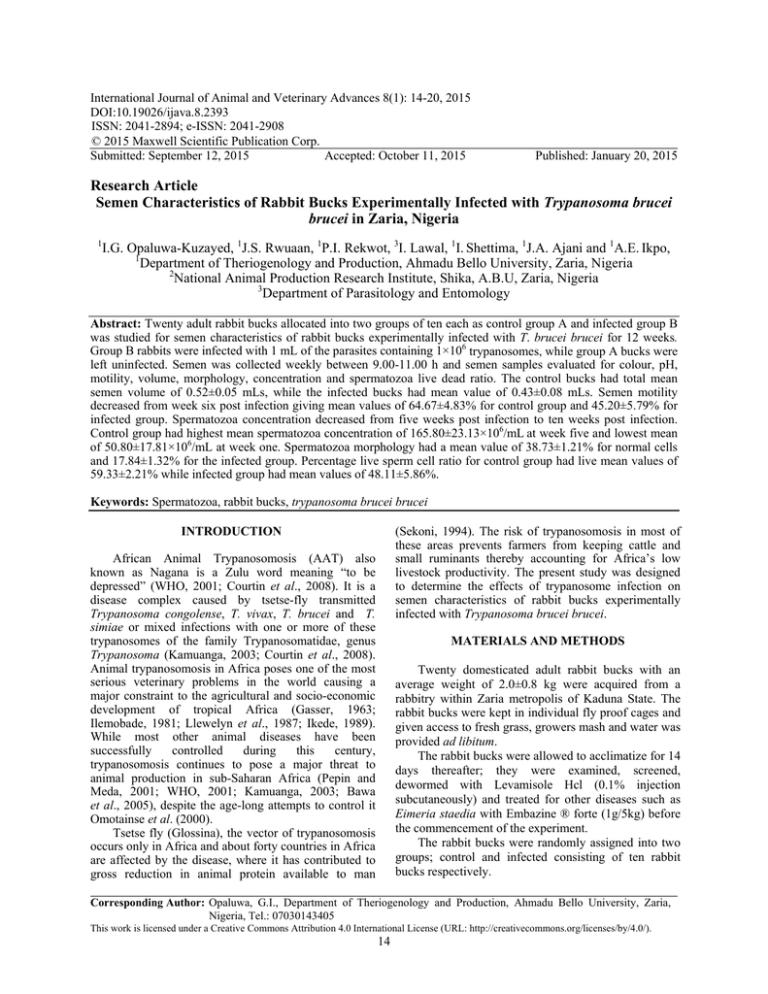
International Journal of Animal and Veterinary Advances 8(1): 14-20, 2015 DOI:10.19026/ijava.8.2393 ISSN: 2041-2894; e-ISSN: 2041-2908 © 2015 Maxwell Scientific Publication Corp. Submitted: September 12, 2015 Accepted: October 11, 2015 Published: January 20, 2015 Research Article Semen Characteristics of Rabbit Bucks Experimentally Infected with Trypanosoma brucei brucei in Zaria, Nigeria 1 I.G. Opaluwa-Kuzayed, 1J.S. Rwuaan, 1P.I. Rekwot, 3I. Lawal, 1I. Shettima, 1J.A. Ajani and 1A.E. Ikpo, 1 Department of Theriogenology and Production, Ahmadu Bello University, Zaria, Nigeria 2 National Animal Production Research Institute, Shika, A.B.U, Zaria, Nigeria 3 Department of Parasitology and Entomology Abstract: Twenty adult rabbit bucks allocated into two groups of ten each as control group A and infected group B was studied for semen characteristics of rabbit bucks experimentally infected with T. brucei brucei for 12 weeks. Group B rabbits were infected with 1 mL of the parasites containing 1×106 trypanosomes, while group A bucks were left uninfected. Semen was collected weekly between 9.00-11.00 h and semen samples evaluated for colour, pH, motility, volume, morphology, concentration and spermatozoa live dead ratio. The control bucks had total mean semen volume of 0.52±0.05 mLs, while the infected bucks had mean value of 0.43±0.08 mLs. Semen motility decreased from week six post infection giving mean values of 64.67±4.83% for control group and 45.20±5.79% for infected group. Spermatozoa concentration decreased from five weeks post infection to ten weeks post infection. Control group had highest mean spermatozoa concentration of 165.80±23.13×106/mL at week five and lowest mean of 50.80±17.81×106/mL at week one. Spermatozoa morphology had a mean value of 38.73±1.21% for normal cells and 17.84±1.32% for the infected group. Percentage live sperm cell ratio for control group had live mean values of 59.33±2.21% while infected group had mean values of 48.11±5.86%. Keywords: Spermatozoa, rabbit bucks, trypanosoma brucei brucei (Sekoni, 1994). The risk of trypanosomosis in most of these areas prevents farmers from keeping cattle and small ruminants thereby accounting for Africa’s low livestock productivity. The present study was designed to determine the effects of trypanosome infection on semen characteristics of rabbit bucks experimentally infected with Trypanosoma brucei brucei. INTRODUCTION African Animal Trypanosomosis (AAT) also known as Nagana is a Zulu word meaning “to be depressed” (WHO, 2001; Courtin et al., 2008). It is a disease complex caused by tsetse-fly transmitted Trypanosoma congolense, T. vivax, T. brucei and T. simiae or mixed infections with one or more of these trypanosomes of the family Trypanosomatidae, genus Trypanosoma (Kamuanga, 2003; Courtin et al., 2008). Animal trypanosomosis in Africa poses one of the most serious veterinary problems in the world causing a major constraint to the agricultural and socio-economic development of tropical Africa (Gasser, 1963; Ilemobade, 1981; Llewelyn et al., 1987; Ikede, 1989). While most other animal diseases have been successfully controlled during this century, trypanosomosis continues to pose a major threat to animal production in sub-Saharan Africa (Pepin and Meda, 2001; WHO, 2001; Kamuanga, 2003; Bawa et al., 2005), despite the age-long attempts to control it Omotainse et al. (2000). Tsetse fly (Glossina), the vector of trypanosomosis occurs only in Africa and about forty countries in Africa are affected by the disease, where it has contributed to gross reduction in animal protein available to man MATERIALS AND METHODS Twenty domesticated adult rabbit bucks with an average weight of 2.0±0.8 kg were acquired from a rabbitry within Zaria metropolis of Kaduna State. The rabbit bucks were kept in individual fly proof cages and given access to fresh grass, growers mash and water was provided ad libitum. The rabbit bucks were allowed to acclimatize for 14 days thereafter; they were examined, screened, dewormed with Levamisole Hcl (0.1% injection subcutaneously) and treated for other diseases such as Eimeria staedia with Embazine ® forte (1g/5kg) before the commencement of the experiment. The rabbit bucks were randomly assigned into two groups; control and infected consisting of ten rabbit bucks respectively. Corresponding Author: Opaluwa, G.I., Department of Theriogenology and Production, Ahmadu Bello University, Zaria, Nigeria, Tel.: 07030143405 This work is licensed under a Creative Commons Attribution 4.0 International License (URL: http://creativecommons.org/licenses/by/4.0/). 14 Int. J. Anim. Veter. Adv., 8(1): 14-20, 2015 a drop of semen on a pre warmed clean glass slide and viewed at a low power magnification (x 40) (AlGhalban et al., 2004). Concentration of spermatozoa was determined by the use of the improved Neubaeur haemocytometer according to the method of Coffin (1953) and Rekwot et al. (1994, 1997). The live/dead ratio was determined as described by Johnson (1994), Esteso et al. (2006) and Koonjaenak (2006). The spermatozoa abnormalities were determined as described by (Koonjaenak, 2006). Experimental infection of the animals: Stabilates of T. brucei brucei were acquired from the Department of Parasitology and Entomology of the Faculty of Veterinary Medicine, Ahmadu Bello University, Zaria, who also sourced it from National Institute of Trypanosomosis Research, Kaduna state. Before infecting the rabbits, the trypanosomes were maintained by serial syringe passages in white rats, and periodically checked for the viability of the parasite. Blood was obtained from the passaged rats by tail bleeding into normal saline and the parasitaemia adjusted to 1×106 trypanosomes per milliliter (mL) by the method of Herbert and Lumsden (1976). Each rabbit in Group B was inoculated intraperitoneally with 1ml of saline diluted blood containing 1×106 trypanosomes T. brucei brucei, while Group A rabbits served as uninfected control. Statistical analysis: Data generated on haematological parameters and semen characteristics (colour, volume, pH and spermatozoa concentration were expressed as mean±Standard Error of the Mean (SEM). Data on motility and percent live/dead of the spermatozoa were expressed as percentages and mean±SEM. In all cases, unpaired t-test was used to test for differences between groups using Graph pad prism version 5.0. Values of p˂0.05 were considered statistically significant. Semen collection and evaluation: Bucks were on a weekly semen collection regimen for two weeks preinfection and ten weeks post infection during the course of the experiment using a specially designed artificial vagina for rabbits by IMV Technologies 2911 model. Lubrication with non perfumed petroleum jelly in the end where intromission of the penis occurs is essential (Dorji, 2012). The rabbit doe was restrained firmly in place allowing for the male exhibit his courting behavior. The buck was allowed few false mounts, after which the person with the artificial vagina collected the ejaculate by directing the penis into the artificial vagina. The test tube containing the ejaculate was carefully handled against foreign bodies, contamination and direct sunlight and cold temperatures (Nuti, 2012). The ejaculated sample was subjected to routine semen evaluations such as semen volume, pH, colour, spermatozoa concentrations, motility, live/dead ratio and morphology (Zemjanis, 1970). The volume of the ejaculate was easily measured according to the method described by Mickelsen et al. (1991). Opacity and color of the samples were coded according to Brito et al. (2002). Sperm motility was assessed subjectively for meaningful results (Brito et al., 2002). Gross motility was assessed based on the swirling activity observed in RESULTS AND DISCUSSION Semen characteristics: Mean semen volume of infected and control rabbit bucks are shown in Table 1. There was statistical significant difference (p˂0.05) in the volume of semen collected in the bucks at weeks 9 and 10. During the course of the experiment the control bucks had a total mean value of 0.52±0.05 mLs, compared to the infected bucks with a total mean value of 0.43±0.08 mLs. The semen volume progressively decreased from week four to week ten post infection, with a mean value of 0.41±0.02 mLs and 0.26±0.10 mLs for the control bucks and infected bucks respectively during the period of decrease. There was a consistent decrease in the semen motility from week six post infection, with a significant difference of (p˂0.05) and mean value of 64.67±4.83% for control group and 45.20±5.79% for infected group. The highest motility was at the beginning of the experiment giving mean values 85.30±4.55% and 77.50±9.17% for control group and infected group respectively, while the lowest motility was at the end of the experiment with mean values of 53.00±12.28% for Table 1: Mean (±SEM) semen volume (mLs) of infected and non infected rabbit bucks pre and post infection Control (n = 10) Infected (n = 10) -------------------------------------------------------------------------------------------Period Time (Weeks) Mean SEM Mean SEM Pre-infection 1 0.48 0.18 0.44 0.19 2 0.53 0.19 0.56 0.12 Week of infection 3 0.72 0.16 0.67 0.16 post infection 4 0.76 0.17 0.63 0.14 5 0.49 0.18 0.54 0.19 6 0.44 0.07 0.54 0.15 7 0.40 0.07 0.45 0.13 8 0.35 0.08 0.17 0.06 0.08 0.05b 9 0.46 0.09a 0.06 0.05b 10 0.42 0.12a ab Means in the same row of each parameter with different superscript letters are statistically (p˂0.05) different 15 Int. J. Anim. Veter. Adv., 8(1): 14-20, 2015 Table 2: Mean (±SEM) spermatozoa motility (%) of infected and non infected rabbit bucks pre and post infection Control (n = 10) Infected (n = 10) ------------------------------------------------------------------------------------------Mean SEM Mean SEM Period Time (Weeks) Pre-infection 1 86.60 3.510 44.25 15.25 2 73.50 2.240 40.00 9.780 Week of infection 3 85.30 4.550 56.11 7.670 Post infection 4 71.90 8.37a 31.00 13.31b 10.81 73.00 5 9.170 77.50 8.270 60.00 6 10.81 37.50 9.97a 70.00 7 9.66 b 26.00 a 62.50 8 37.00 8.51 6.51b 68.50 9 61.90 12.51 8.920 53.00 10 22.00 4.61 b 12.28a ab Means in the same row of each parameter with different superscript letters are statistically (p˂0.05) different Table 3: Mean (±SEM) spermatozoa concentration (×106/mL) of control and infected rabbit bucks pre and post infection Control (n = 10) Infected (n = 10) ------------------------------------------------------------------------------------------Mean SEM Mean SEM Period Time (Weeks) Pre-infection 1 50.800 17.81 45.70 17.64 2 50.800 17.81 45.70 17.64 Week of infection 3 50.800 17.81 45.70 17.64 Post infection 4 109.00 8.46a 39.30 23.79b 5 165.80 23.13a 87.80 25.26 b 6 134.20 9.92a 45.40 19.54b 7 118.70 13.51a 32.60 8.57b 8 117.50 5.82a 42.80 23.45b a 9 113.80 19.40 32.00 10.61b 10 143.30 13.80a 38.70 30.11b ab Means in the same row of each parameter with different superscript letters are statistically (p˂0.05) different Table 4: Mean (±SEM) % values of spermatozoa morphological abnormalities of infected and non-infected rabbit bucks pre and post infection Control n = 10 Infected n = 10 ---------------------- ---------------------Variable Mean SEM Mean SEM Normal spermatozoa cells 38.73 1.21 17.84 1.32 Detached heads 9.460 1.57 3.850 0.40 Folded tails 8.430 1.05 3.920 0.54 Bent tails 11.35 0.90 6.360 1.18 bent tails for the control group was 11.35±0.90% and 6.36±1.18% for infected group. This is illustrated in Table 4. There was statistical significant difference in the percentage live sperm cell ratio at weeks nine and ten. Control group had live mean values of 59.33±2.21% compared to infected group that had live mean values of 48.11±5.86% as presented in Table 5. The Trypanosoma brucei brucei used in this study caused clinical trypanosomosis in all the infected rabbits showing a marked pathogenicity in consistence with the findings in Trypanosoma congolense infected rabbits (Takeet and Fagbemi, 2009), Trypanosoma congolense infection in rats (Egbe-Nwiyi et al., 2005) and Trypanosoma brucei brucei infection in rabbits (Orhue et al., 2005). The infection did not cause any death which is presumed to be due to the strain of the parasite used in this work. The infected rabbit bucks had an average prepatent period of six days post infection which gradually rose to a peak by the 10th day post infection thereby followed by a fluctuating parasitaemia and anorexia. Emaciation in the infected bucks was consistent with the findings of Ogunsanmi et al. (1994) and Omotainse et al. (1994) which was reported to be as a result of the trypanolytic crisis which occurs in the peripheral blood of the infected host in the early stage of the disease (Seifert, 1996). Ogwu (1983) and Agu and Bajeh (1986) reported an eventual disappearance of parasites from peripheral circulation which was also observed during the course of this experiment 28 days post infection. control group and 22.00±8.95% for infected group as shown in Table 2. Table 3 shows spermatozoa concentration which progressively decreased from five weeks post infection to ten weeks post infection, with significant difference (p˂0.05). Control group had the highest spermatozoa concentration of 165.80±23.13×106/mL at week five and lowest of 50.80±17.81×106/mL at week one. Infected group had the highest sperm concentration of 87.80±25.26×106/mL in the fifth week post-infection. Thereafter, there was a continual decreasing fluctuation with mean values of 45.40±19.54×106/mL at week six till the end of the experiment giving mean values of 38.70±30.11×106/mL at week ten post infection. Experimental trypanosomosis also had effects on sperm morphology, with significant difference (p˂0.05) and consistent fluctuations. The control group had a mean value of 38.73±1.21% for normal cells and 17.84±1.32% for the infected group, detached heads had a mean value of 9.46±1.57% and 3.85±0.40% for control and infected groups respectively. Folded tails had mean values of 8.43±1.05% for control group and 3.92±0.54% for infected group. The mean values for 16 Int. J. Anim. Veter. Adv., 8(1): 14-20, 2015 Table 5: Mean (±SEM) live spermatozoa (%) of infected and non infected rabbit bucks pre and post infection Control (n = 10) Infected (n = 10) ---------------------------------------------------------------------------------------------Period Time (Weeks) Mean SEM Mean SEM Pre-infection 1 58.00 8.670 58.00 8.670 Week of infection 2 58.00 8.670 58.00 8.670 Post infection 3 68.00 4.670 56.00 6.860 4 67.00 7.750 66.00 2.210 5 61.00 7.060 57.00 6.510 6 66.00 7.770 56.00 7.180 7 51.00 10.27 30.00 10.43 8 51.00 10.27 41.90 9.000 9 54.00 10.13a 11.00 7.06b a 11.00 7.06 b 10 67.00 7.75 ab Means in the same row of each parameter with different superscript letters are statistically (p˂0.05) different spermatogenesis by pathogens or other structures regulating the spermatogenic tissues will result in reduction of ejaculate qualities (White, 1933; Noakes et al., 2001). Since Trypanosoma brucei brucei is tissue invasive, the observed reduction in ejaculate characteristics can be linked to the effects of the infection. Some pathogenic effects on the male reproductive systems have been reported. The reduced libido, increased scrotal diameters, scrotal inflammations, alopecia, periorchitis, severe testicular degenerations, balanitis, abnormal spermatogenesis in the infected rabbit bucks agrees with the findings of trypanosoma infected animals as reported by Ikede and Akpavie (1982) and Sekoni (1991, 1992), which may be influenced by the effect of trypanosomes on the test is affecting the leydig cell steroidogenesis (Sekoni et al., 1988a) through the indirect effects of pyrexia and the accompanying waves of increasing parasitaemia during infection and increased scrotal temperatures (Mutayoba et al., 1995). There were genital lesions within 13-29 days post infection such as alopecia, periorchitis, epididymitis, severe testicular degeneration and haemorhage and deteriorated semen characteristics which agrees with reports by Isoun and Anosa (1974) and Anosa and Isoun (1980). Agu and Bajeh (1986) reported deteriorated semen characteristics in rams infected with T. vivax which was a consistent finding in this study. There was a consequent reduction in the volume of semen collected and also a reduction in the gross motility and concentration of the sperm cells with an increased number of morphological defective sperm cells such as the detached heads, free tails, bent tails and coiled tails which agrees with the findings of Akpavie et al. (1986), Sekoni et al. (1990a) and Sekoni (1993) who reported aspermatogenesis and various sperm abnormalities in trypanosomosis infected animals. There are direct and indirect detrimental effects of trypanosomosis on reproduction in male and female animals. It is well established that most tissues and organs are damaged during the course of infection (Morrison et al., 1981). The reproductive system which is controlled by a well co-ordinated and efficient neuroendocrine system (Nalbandov, 1976), has been reported in literature to be affected in both natural and experimental trypanosome infections (Isoun and Anosa, 1974; Ikede et al., 1988). The hormones involved in reproduction originate in three principal structures which are the hypothalamus, the pituitary and the gonads. Any detrimental effect on any of the organs would result in detrimental effects on reproduction. It has been well established that severe degenerative changes of the interstitial cells of leydig within the testes takes place, and this cells are responsible for the production of testosterone, which is the hormone responsible for libido, anabolic effects and secondary male characteristics (Sekoni, 1991). Therefore, poor libido or lack of libido in all male species with trypanosomosis is a possibility, which can be supported by the observations of Mulligan et al. (1970) who reported that chronic T. congolense infections in cattle may lead to loss of libido, interference with reproduction and delayed puberty in calves. Waindi et al. (1986) found low levels of plasma testosterone in goats infected with T. congolense. Hoogenboezeom and Swanepoel (2001) reported that testicular degeneration might be due to nutritional deficiencies and management related factors. Degenerative changes in the seminiferous tubules, testicular degeneration, low semen output, low spermatozoa concentration, high percentage of dead spermatozoa and spermatozoa abnormalities have also been reported to be caused by heat stress (Kumi-Diaka et al., 1981; Sekoni et al., 1991; Mamabolo, 1999; Hoogenboezeom and Swanepoel, 2001). Spermatozoon is produced from the seminiferous tubule of the test is in a complex process known as spermatogenesis (Roosen-Runge, 1977). The process of spermatogenesis is under the control and influence of both the endocrine and certain external factors such as photoperiod and presence of noxious agents (Ortavant et al., 1977; MacDonald and Pineda, 1989). Any effect such as invasion of the tissues involved in CONCLUSION In this study, spermatozoa motility and concentration were significantly reduced, while morphological abnormalities of spermatozoa increased. These characteristics of the ejaculate are not only vital 17 Int. J. Anim. Veter. Adv., 8(1): 14-20, 2015 to the physiological functions of the spermatozoa, which include spermatozoa migration and fertilization, but are also considered in the evaluation of an animal for breeding soundness. This means that either or both natural and experimental Trypanosoma brucei brucei infection of bucks will result in reduced spermatozoa migration and fertilization and also the rejection of such bucks as potential breeders. Esteso, M.C., M.R. Ferna´ndez-Santos, A.J. Soler, V. Montoro, A. Quintero-Moreno and J.J. Garde, 2006. The effects of cryopreservation on the morphometric dimensions of Iberian red deer (Cervus elaphus ispanicus) epididymal sperm heads. Reprod. Domes. Anim., 41: 241-246. Gasser, H.S., 1963. The bane of tropical Africa. Lancet, 1: 1091. Herbert, W.J. and W.H.R. Lumsden, 1976. Trypanosoma brucei: A rapid “matching” method for estimating the host’s parasitaemia. Exp. Parasitol., 40: 427-431. Hoogenboezeom and Swanepoel, 2001. Zootech, aspect of bull fertility. Animal Genetic Resource. Iowa state University Press. Ikede, B.O., 1989. Control of animal trypanosomiasis in Nigeria as a strategy for increased livestock production. Proceedings of a Preparatory Workshop, held at Vom, Plateau State, Nigeria, June 5-9. Ikede, B.O. and S.O. Akpavie, 1982. Delay in resolution of trypanosoma induced genital lesions in male rabbits infected with T. brucei and infected with Diminazene aceturate. Res. Veter. Sci., 32: 374-376. Ikede, B.O., E. Elhassan and S.O. Akpavie, 1988. Reproductive disorders in African Trypanosomiasis: A review. Acta Trop., 45(1): 5-10. Ilemobade, A.A., 1981. Research in field of animal trypanosomiasis in Nigeria: An overview. Proceedings of the 1st National Conference on Tsetse and Trypanosomiasis Research in Kaduna. Isoun, T.T. and V.O. Anosa, 1974. Lesions in the reproductive organs of sheep and goats infected with Trypanosoma vivax. Z. Tropenmed. Parasitology, 25: 469-476. Johnson, I., 1994. Spermatogenesis in bulls. Proceedings of the 15th Technical Conferenceon Artificial Insemination and Reproduction, Columbia, Missouri, pp: 9-27. Kamuanga, M., 2003. Socio-Economic and Cultural Factors in the Research and Control of Trypanosomosis. FAO, Rome, pp: 67. Koonjaenak, S., 2006. Semen and spermatozoa characteristics of swamp buffalo (Bulbalus bubalis) bulls for Artificial Insemination in Thailand in relation to season. Doctoral Thesis. Faculty of Veterinary Medicine and Animal Science. Sweedish University of Agric Science. Acta Universitatis Agruculturae Suecieae, Uppsala, Sweeden, 114: 55. Kumi-Diaka, J., V. Nagerathman and J.S. Rwuaan, 1981. Seasonal age related changes in semen quality and testicular morphology in bulls in the tropics. Veter. Records, 108: 13-15. Conflict of interest: The authors declare no conflict of interest. REFERENCES Agu, W.T. and Z.T. Bajeh, 1986. An outbreak of Trypanosoma brucei brucei in pigs, in Benue State, Nigeria. Trop. Veter., 4: 25-28. Akpavie, S.O., B.O. Ikede and G.N. Egbunike, 1986. Ejaculate characteristics of sheep infected with Trypanosoma brucei and Trypanosoma vivax: changes caused by treatment with diminazene aceturate. Res. Veter. Sci., 42(1): 1-6. Al-Ghalban, A.M., M.J. Tabbaa and R.T. Kridli, 2004. Factors affecting semen characteristics and scrotal circumference in Damascus bucks. Small Rumin. Res., 53: 141-149. Anosa, V.O. and T.T. Isoun, 1980. Further observations on the testicular pathology in Trypanosoma vivax infection of sheep and goats. Res. Veter. Sci., 28: 151-160. Bawa, E.K., V.O. Sekoni, D. Ogwu, K.A.N. Esievo and D.V. Uza, 2005. Results of Novidium (Homidium chloride) chemotherapy on clinical manifestation of Trypanosoma vivax infected pregnant Yankasa and West African Dwarf (WAD) Ewes. J. Anim. Veter. Adv., 4(7): 637-641. Brito, L.F.C., A.E.D.F. Silva, L.H. Rodrigues, F.V. Vieira, L.A.G. Deragon and J.P. Kastelic, 2002. Effects of environmental factors, age and genotype on sperm production and semen quality in Bos indicus and Bos Taurus AI bulls in Brazil. Anim. Reprod. Sci., 70(3-4): 181-190. Coffin, D.L., 1953. Enumeration of Mammalian Spermatozoa. Manual of Veterinary Clinical Pathology. 3rd Edn., Comstock Publication Company, Ithaca, New York. Courtin, D., D. Berthier, S. Thevenon, G.K. Dayo, A. Garcia and B. Bucheton, 2008. Host genetics in African trypanosomiasis. Infect. Genet. Evol., 8(3): 229-238. Dorji, T., 2012. Semen collection. Animal reproduction. Pp. 1- 5. Egbe-Nwiyi, T.N., I.O. Igbokwe and P.A. Onyeyili, 2005. Pathogenicity of Trypanosoma congolense infection following oral calcium chloride administration in rats. African J. Biomed. Res., 8: 197-201. 18 Int. J. Anim. Veter. Adv., 8(1): 14-20, 2015 Orhue, N.E.J., E.A.C. Nwanze and A. Okafor, 2005. Serum total protein, albumin and globulin levels in Trypanosoma brucei infected rabbits: Effects of orally administered Scoparia dulcis. African J. Biotechnol., 4(10): 1152-1155. Ortavant, R., M. Courot and H. de Reviers, 1977. Spermatogenesis in Domestic Mammals. In: Reproduction in Domestic Animals. Academic Press, London, pp: 223-234. Pepin, J. and H.A. Meda, 2001. The epidemiology and control of human African trypanosomiasis. Adv. Parasitol., 49: 71-132. Rekwot, P.I., E.O. Oyedipe, P.M. Dawuda and V.O. Sekoni, 1997. Age and hourly related changes of serum testosterone and spermiogram of prepubertal bulls fed two levels of nutrition. Veter. J., 153: 341-347. Rekwot, P.I., E.O. Oyedipe and O.W. Ehoche, 1994. The effects of feed restriction and realimentation on the growth and reproductive function of Bokoloji Bulls. Theriogenology, 42: 287-295. Roosen-Runge, E.C., 1977. The Process of Spermatogenesis in Animals. Cambridge University Press, London, pp: 1-12. Seifert, H.S.H., 1996. Tropical Animal Health Kluwer Academic Publishers. Dorrech, Bonston, London, ISBN: 0-7923-3821-9, pp: 53-260. Sekoni, V.O., 1991. Animal trypanosomiasis and reproductive disorders. Proceedingd of the Symposium in National Animal Production Research Institute, April 25. Sekoni, V.O., 1992. Effects of T. vivax infection of sperm characteristics of yankasa rams. British Veter. J., 148: 501-506. Sekoni, V.O., 1993. Elevated sperm morphological abnormalities of yankasa rams consequent to trypanosomosis. Anim. Reprod. Sci., 31: 243-248. Sekoni, V.O., 1994. Reproductive disorders caused by animal trypanosomiasis: A review. Theriogenology, 42(4): 557-570. Sekoni, V.O., J. Kumi-Diaka, D. Saror and C. Njoku, 1988a. The effects of T. vivax and T. congolense infection on the reaction time and semen characteristics in the zebu bull. British Veter. J., 144: 388-394. Sekoni, V.O., C.O. Njoku, J. Kumi-Diaka and D.I. Saror, 1990a. Pathological changes in male genitalia of cattle infected with Trypanosoma vivax and Trypanosoma congolense. British Veter. J., 146: 175-180. Sekoni, V.O., D.I. Saror, C.O. Njoku and J. KumiDiaka, 1991. Effects of Novidium (Homidium chloride) chemotherapy on elevated spermatozoa morphological abnormalities in the semen of zebu bulls infected with T. vivax and T. congolense. Anim. Reprod. Sci., 24: 249-258. Takeet, M.I. and B.O. Fagbemi, 2009. Haematological, pathological and plasma biochemical changes in rabbits experimentally infected with Trypanosoma congolense. Sci. World J., 4(2). Llewelyn, C.A., A.G. Lunkins, C.D. Monro and J. Perrie, 1987. The effect of Trypanosoma congolense infection on the estrus cycle of the goat. British Veter. J., 143: 423-431. MacDonald, L.E. and M.H. Pineda, 1989. Veterinary Endocrinology and Reproduction. Philadelphia, Lea and Febiger. Mamabolo, M.J., 1999. Dietary, seasonally and environmental influence on semen quality and fertility status of indigenous goats. Mpumalonga province, South Africa. PhD Thesis. University of Pretoria, South Africa. Mickelsen, W.D., L.G. Paisley and J.J. Dahmen, 1991. The effect of season on the scrotal circumference and spermatozoa motility and morphology in rams. Theriogenology, 16: 45-51. Morrison, I., M. Murray and I. Mcintyre, 1981. Bovine trypanosomiasis, FAO/SIDA follow up seminar on veterinary pathology, Faculty of Veterinary Medicine, University of Nairobi, September 7-27. Mulligan, H.W., W.H. Potts and W.E. Kershaw, 1970. The African Trypanosomiasis. George Allenand Unwin Ltd., London, pp: 661-794. Mutayoba, B.M., P.D. Eckersall, V. Cestnik, I.A. Jeffcoate, C.E. Gray and P.H. Holmes, 1995. Effects of T. congolense on pituitary and adrenocortical function in sheep. Changes in the adrenal gland and cortisol secretion. Res. Veter. Sci., 58: 174-179. Nalbandov, A.V., 1976. Reproductive Physiology of Mammals and Birds. 3rd Edn., W.H. Freeman and Company, San Francisco, pp: 334. Noakes, D.E., T.J. Parkinson and G.C.W. England, 2001. Arthur”s Veterinary Reproduction and Obstetrics. Saunders, New York. Nuti, L.C., 2012. Goat Semen Collection and Processing. Retrieved from: Www. Goatsemennuti. Pdf, (Accessed on: July 06, 2012). Ogunsanmi, A.O., S.O. Akpavie and V.O. Anosa, 1994. Serum biochemical changes in WAD sheep experimentally infected with Trypanosoma brucei brucei. d’Elevage et de Medecine in dogs. Israel J. Veter. Med., 49(1): 36-39. Ogwu, D., 1983. Effects of trypanosoma vivax infection on female reproduction in cattle. Ph.D Thesis in the Department of Surgery and Medicine, Faculty of Veterinary Medicine, Ahmadu Bello University, Zaria. Omotainse, S.O., V.O. Anosa and C. Falaye, 1994. Clinical and biochemical changes in experimental Trypanosoma brucei infection in dogs. Israel J. Veter. Med., 49(1): 36-39. Omotainse, S.O., H. Edegbhere, G.A. Omoogum, G. Thompson, C.A. Igweh et al., 2000. The prevalence of animal trypanosomosis in Konshisha Local Government Area of Benue State Nigeria. Israel Veter. J., 55(4). 19 Int. J. Anim. Veter. Adv., 8(1): 14-20, 2015 WHO (World Health Organisation), 2001. Tropical Diseases Database. Retrieved from: http://wwwnt.who.int./imagelib.pl. Zemjanis, R., 1970. Diagnostic and Therapeutic Techniques in Animal Reproduction. Williams and Wilkins, Baltimore. Waindi, E.N., S. Gombe and D. Odour-Okelo, 1986. Plasma testosterone in Toggerburg goats. Arch. Androl., 17: 9-17. White, W.E., 1933. Duration of fertility and the histological changes in the reproductive organs after ligation of the vasa efferentia in the rat. Proceedings of the Royal Society, London, B113: 544-550. 20

